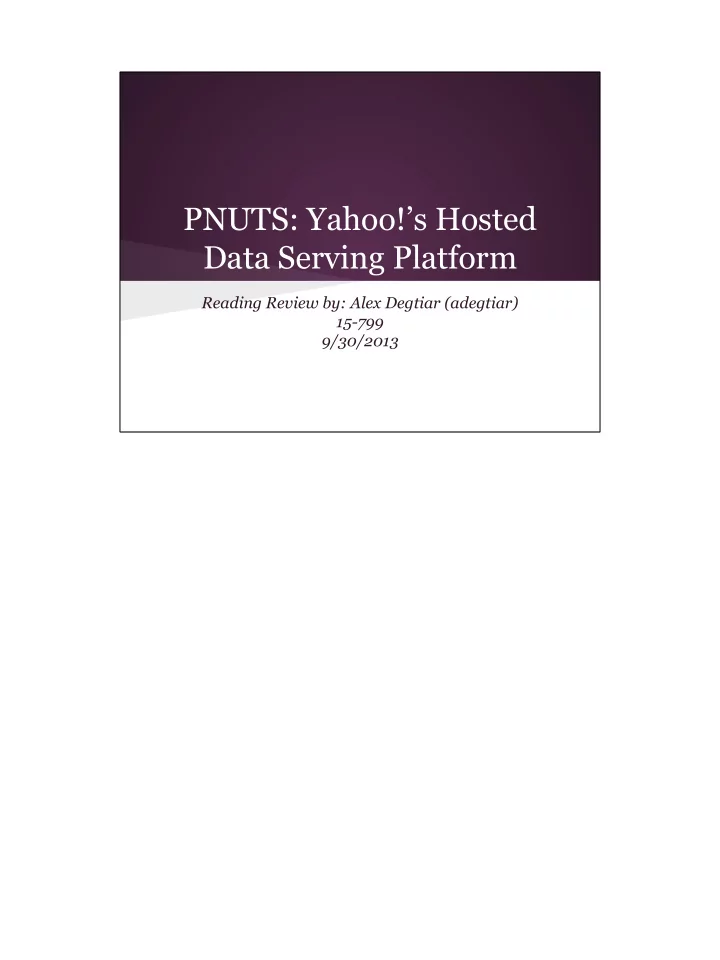

PNUTS: Yahoo!’s Hosted Data Serving Platform Reading Review by: Alex Degtiar (adegtiar) 15-799 9/30/2013
What is PNUTS? ● Yahoo’s NoSQL database ● Motivated by web applications ● Massively parallel ● Geographically distributed ● Per-record consistency web apps, not complex queries
Goals and Requirements ● Scalability ● Response Time and Geographic Scope ● High Availability and Fault Tolerance ● Relaxed Consistency Guarantees 1. Scalability (architectural, handle periods of rapid growth) 2. Response Time and Geographic Scope (reads from nearby server -> low latency for users across the globe) 3. High Availability and Fault Tolerance (read & write availability, handle server failures, network partitions, power loss, etc)) 4. Relaxed Consistency Guarantees
Consistency ● Tradeoff between performance, availability, consistency ● Serializable transactions expensive in distributed systems ● Strong consistency not always important for web apps ● Want to make it easy to reason about consistency
Eventual Consistency ● Updates to photo metadata on social site ○ U1: Remove his mother from the list of people who can view his photos ○ U2: Post spring-break photos
Per-record timeline consistency ● All replicas of a record apply record updates in same order
API and Specified Consistency ● Read-any ● Read-critical(>=version) ● Read-latest ● Write ● Test-and-set-write(version)
Per-Record Timeline Consistency example ● U1: Remove his mother from the list of people who can view his photos ● U2: Post spring-break photos
Data Model ● Simplified relational data model ● Tables of records with attributes ● Blob data types w/ arbitrary structures ● Updates/deletes specify primary key ● Point/range access ● Parallel multi-get range has predicate no complex queries, no constraint enforcement
Tables and Tablets ● Tables (ordered, hash) ● Partitioned into tablets Hash more efficient at load balancing
Architecture ● Regions with identical components
Storage Units ● Physical data storage nodes ● API: GET/SET/SCAN
Tablet Controller ● Holds interval -> tablet mappings ● Remaps under load imbalance ● Handles failure
Tablet splitting and balancing
Router ● Routes requests ● Keeps tablet mapping cache on error from SU, updates cache
Message Broker (YMB) ● Persistently updates logs ● Guarantees in-order delivery - pub/sub ● Sends updates to master on error from SU, updates cache
Record-Level Mastering ● Each record has chosen master ● Master updated for locality ● Update ○ Sent to master node ○ Sent to YMB & committed ○ Forwarded to slave nodes ● Tablet master selected for each tablet ○ Ensures no duplicate inserts on primary key ~85% of reads/writes are with good locality/latency history of 3 masters kept - if changing, relocate master.
Failure and Recovery Copy lost tablets from another replica 1. Tablet controller requests from “source tablet” replica 2. Checkpoint message to YMB to ensure in- flight updates reach source replica 3. Source tablet copied to new region Made possible by synchronized split boundaries
Other Features ● Scatter-gather engine ○ Part of router ○ Can support Top-K in range query ● Notifications ○ Pub/sub support via YMB ● Hosted database service ○ Balances capacity among added servers ○ Automatic recovery ○ Isolation between different workloads/applications (via different SU)
Experimental Results ● 1 router, 2 message brokers, 5 storage units ● High cost for inserts in non-master region
More Experimental results
Limitations ● No multi-record transactions ● Record-level consistency forces use of same model for in-order updates ● Poor latency guarantees ○ Writes & consistent reads go to (possibly remote) master ● Optimized for read/write single records and small scans (tens or hundreds of records)
Other Criticisms ● Range scans don’t scale ● Slow/expensive failure recovery ● Unclear how YMB works/scales ● On-record-at-a-time consistency not always enough ● Experiment not very large scale ○ Is scale tested at all? ○ Ordered table not tested at scale… hot keys?
Future Work ● Bundled updates ○ Multi-record consistency ● Relaxed consistency ○ e.g. for major region outages ● Indexes and materialized view via update stream ● Batch-query processing
PNUTS Conclusion ● Rich database functionality and low latency at massive scale ● Async replication ensures low latency w/ geographic replication ● Per-record timeline consistency model ● YMB as replication mechanism + redo log ● Hosted service to minimize operation cost
Acknowledgements Information, figures, etc. PNUTS: Yahoo!'s Hosted Data Serving ● Platform , B. Cooper, et al. ● Consistency and tablet diagrams adapted/taken from Yahoo talk. http: //www.slideshare.net/smilekg1220/pnuts-12502407. ● Relevant source overview to help understand the material: http://the-paper- trail.org/blog/yahoos-pnuts/ .
Recommend
More recommend